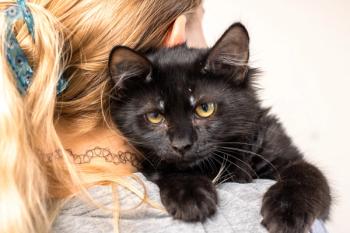
- dvm360 August 2020
- Volume 51
- Issue 8
Is your shelter fit for kitten foster care?
If you're pussyfooting around the idea of starting up a kitten foster care program, shelter medicine expert Dr. Amanda Dykstra can help you think through the resources youll need. And if youre already up to your ears in foster kittens, its not too late to take some good advice.
Andrii Zastrozhnov/stock.adobe.comWho's afraid of a teensy-weensy kitten? Plenty of veterinary professionals.
“I think because a lot of us don't work with neonate kittens very often, they kind of scare us a bit,” says Amanda Dykstra, DVM, MPH, DABVP (Shelter Medicine Practice), a
Dr. Dykstra insists this ignorance shouldn't cause feelings of inadequacy. She cites a 2015 study in which deceased kittens whose causes of death were unknown were sent to a pathologist for necropsy.1 “Even the specialist didn't know what was wrong with 72% of them,” she says. “So if you feel like you don't know what's going on with kittens, don't feel bad. Nobody does.”
What it takes to be fit
But despite this vote of confidence in your kitten care abilities, Dr. Dykstra cautions against jumping into a kitten foster care program too quickly as she's seen many well-meaning organizations get in over their heads.
“Things can get messy fast,” she explains. “I once did a consult for a shelter with a small facility and staff. They only had about 19 cats in the shelter, but when I asked how many cats they had in foster care, the number was over 700.”
Kitten foster care programs require a lot of forethought because they aren't a one-size-fits-all endeavor. In fact, according to Dr. Dykstra, it can be an incredibly bad idea for some shelters.
“If you're at a shelter where you're euthanizing healthy cats, a kitten foster program isn't the best use of your resources,” she says. “You don't want to send this kitten through eight weeks of foster care only to have it euthanized in the end. But if all of your kittens and most of your cats are getting adopted, fostering could be a good option.”
If your shelter falls into the latter category, you'll still need to think through the following resource needs:
Take those intakes seriously
Intake exams are vitally important, so Dr. Dykstra recommends that shelters use either a veterinarian or a highly skilled veterinary technician. “What you don't want to do is send a sickly kitten home with a foster family that gets overly attached,” she explains. “Then you'll be in the position of trying to treat a kitten that's probably not going to make it, spending a ton of money on a specialist or euthanizing a kitten the foster family has come to love.”
Staff. Who's going to handle the medical care of these kittens? “If you're a contract veterinarian, or if you just sometimes work with the shelter, or even if you're full-time at the shelter but it has an intake of 4,000 or so, you're probably busy enough,” says Dr. Dykstra.
Here's why: In addition to providing intake exams, you'll need someone to be available for follow-up appointments, vaccinations, surgeries (which can extend beyond sterilization, as Dr. Dykstra described performing hernia surgery on a kitten weighing 0.8 lb) and perhaps even intensive and emergency care.
A properly functioning kitten foster care program also requires staff to recruit and train foster parents, field phone calls (Dr. Dykstra notes that foster parents of kittens tend to think a lot of things qualify as “emergencies”), keep up-to-date records and coordinate adoptions (preferably offsite). Dr. Dykstra says it can be helpful to designate either an employee or high-capacity volunteer to be the program's coordinator. As the main liaison between foster parents and the shelter, the coordinator can help ensure that foster kittens move into their respective homes as quickly as possible.
Foster parents. Naturally, a successful kitten foster care program requires a solid supply of foster parents. And according to Dr. Dykstra, variety is key. “You'll want to recruit a wide range of lifestyles and personalities to meet the different needs of the kittens in your program,” she explains. “For the kitten that needs to be fed every couple of hours, a young college student on summer break could be the perfect fit. But for the 3-week-old kitten in need of socialization, a retired person who can sit with it on their lap for a good portion of the day would be ideal.”
Frank feral discussion
Dr. Dykstra gets asked about ferals a lot and acknowledges that there are many differing opinions (and that sharing these opinions can get quite heated). She says that according to most experts, if you have a feral kitten that's still truly feral (i.e. not just “less social”) at 9 weeks old, the chances of it becoming a socialized housecat are very slim.
“So if you don't have a lot of foster homes available, the kittens over 9 weeks old are the ones you'll probably want to go ahead and send back out as a part of your trap-neuter-release program,” says Dr. Dykstra. “And then you can focus those foster socialization resources on younger ferals.”
Dr. Dykstra also notes the importance of having informed foster parents. She recommends hosting foster orientations at the shelter to provide education to new recruits. According to Dr. Dykstra, one of the most crucial things you can do with this time is help set realistic expectations. “You need your foster families to know that not all kittens survive-in the wild and in foster care,” she says. “Unrealistic expectations can turn what should be a happy foster program into something that's miserable for everyone involved.
Supplies. Kittens are small, but their needs can be mighty. Everyday items like food and litter can add up fast (not to mention medical supplies-more on that
“When starting a kitten foster care program at a shelter I worked at in Missouri, we kicked things off with a kitten shower, and it was amazing,” she says. “We made a flyer of things we needed, and we also created an Amazon wish list. On the day of the event, we had kittens in little playpens, and members of the community stopped by to bring in ‘presents' for them. All of our food, litter and other resources like scales for that spring's influx of kittens were taken care of by that shower.”
Other resources you'll want to consider include a kitten foster manual to send home with foster parents (more on that
Dr. Dykstra also notes the prudence of including a clause about zoonotic diseases. “Again, this is why the intake exam is so important and why you need to have the proper equipment. If you unintentionally send a kitten with ringworm to a foster home and the kitten passes the fungal infection on to the foster family, it's good to have some protection in your contract,” she says.
More foster kitten facts
Get tips from Dr. Dykstra on:
>
>
Social support
There's one more thing you'll need (or at least want to consider): Facebook. Love it or loathe it, Dr. Dykstra says Facebook and other social media networks can be an effective way to recruit foster parents and solicit donations of supplies like food and litter. She also notes that foster parents would be wise to use social media to find homes for their kittens, as they're in the best position to act as an ambassador for the animal.
Reference
1. Young CN, Haldorson G, Memon MA. Diagnosis of canine and feline neonatal death: A retrospective study: 107 cases (2000-2010). Theriogenology 2015;7:53-57.
Sarah Mouton Dowdy, a former associate content specialist for dvm360.com, is a freelance writer and editor in Kansas City, Missouri.
Articles in this issue
over 5 years ago
Gene editing in animals: Miracle or madness?over 5 years ago
Compassion-First adds 43rd veterinary practiceover 5 years ago
First diagnostic test for canine IBD now availableover 5 years ago
FDA approves generic carprofen chewable for dogsover 5 years ago
When cats get hangry…over 5 years ago
Why we need more veterinary colleges at HBCUsover 5 years ago
DNA debunks age-old ratio for dog years to human yearsover 5 years ago
Quiet, please!Newsletter
From exam room tips to practice management insights, get trusted veterinary news delivered straight to your inbox—subscribe to dvm360.





